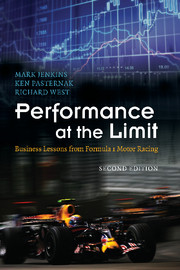Book contents
- Frontmatter
- Contents
- List of figures
- List of tables
- List of plates
- Acknowledgements
- Note on the reference system
- The Grand Prix experience
- 1 Introduction
- 2 Why Formula 1 motor racing?
- 3 The performance framework
- 4 The war for talent
- 5 Winning through teamwork
- 6 Capability through partnerships
- 7 The high-performance organisation
- 8 Integrating
- 9 Innovating
- 10 Transforming
- 11 Achieving and sustaining performance
- 12 Twelve business lessons from Formula 1 motor racing
- Appendix A Grand Prix Champions 1950–2008
- Appendix B Grand Prix Graveyard 1950–2008
- Appendix C Interview respondents
- References
- Index
- Plate section 1
- Plate section 2
10 - Transforming
breaking out of the old ways
Published online by Cambridge University Press: 05 August 2013
- Frontmatter
- Contents
- List of figures
- List of tables
- List of plates
- Acknowledgements
- Note on the reference system
- The Grand Prix experience
- 1 Introduction
- 2 Why Formula 1 motor racing?
- 3 The performance framework
- 4 The war for talent
- 5 Winning through teamwork
- 6 Capability through partnerships
- 7 The high-performance organisation
- 8 Integrating
- 9 Innovating
- 10 Transforming
- 11 Achieving and sustaining performance
- 12 Twelve business lessons from Formula 1 motor racing
- Appendix A Grand Prix Champions 1950–2008
- Appendix B Grand Prix Graveyard 1950–2008
- Appendix C Interview respondents
- References
- Index
- Plate section 1
- Plate section 2
Summary
There is no silver bullet to achieving success at Honda Formula 1, no switches that can be turned. We have to make sure that we are progressing all the time and that next year’s car is better than this year’s and the year after that is better than the year before and over a period we will achieve our ambitions.
Ross Brawn, Team Principal, Honda Racing F1 teamChange is all-pervasive in Formula 1, whether it is the hundreds of small design changes made to a car during the course of a year, or the fact that the individuals employed within Formula 1 are likely to work for eight different teams during the course of their careers. The teams themselves have an average lifetime of less than six years (115 constructor teams since 1950!) and are frequently either dissolved or acquired by other teams, creating a constant state of flux.
There are many explanations for the constant pace of change that pervades Formula 1. Not least is the incessant search for technological advantage. As a consequence, many radical ideas have disrupted the evolution of the Formula 1 car. These have included such developments as gas turbines, four-wheel drive and six-wheel cars.
In Formula 1 regulation not only responds to and tempers technological advances, it also causes change. There regulation can be a contentious issue and often the focus of political manoeuvring by the teams to try to ensure that changes benefit their own situation and disadvantage their competitors. The pressures for regulation can be grouped around three key areas: safety, competitive racing and cost reduction.
- Type
- Chapter
- Information
- Performance at the LimitBusiness Lessons from Formula 1 Motor Racing, pp. 178 - 210Publisher: Cambridge University PressPrint publication year: 2009



